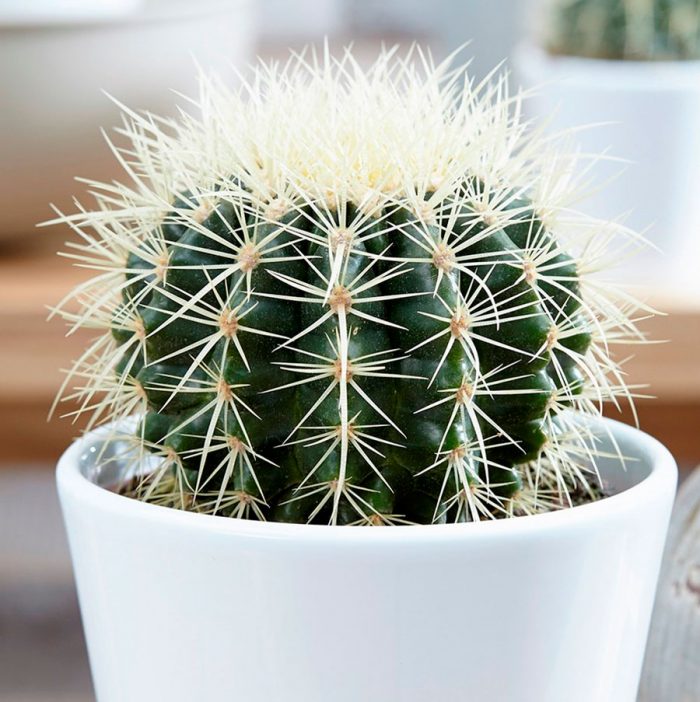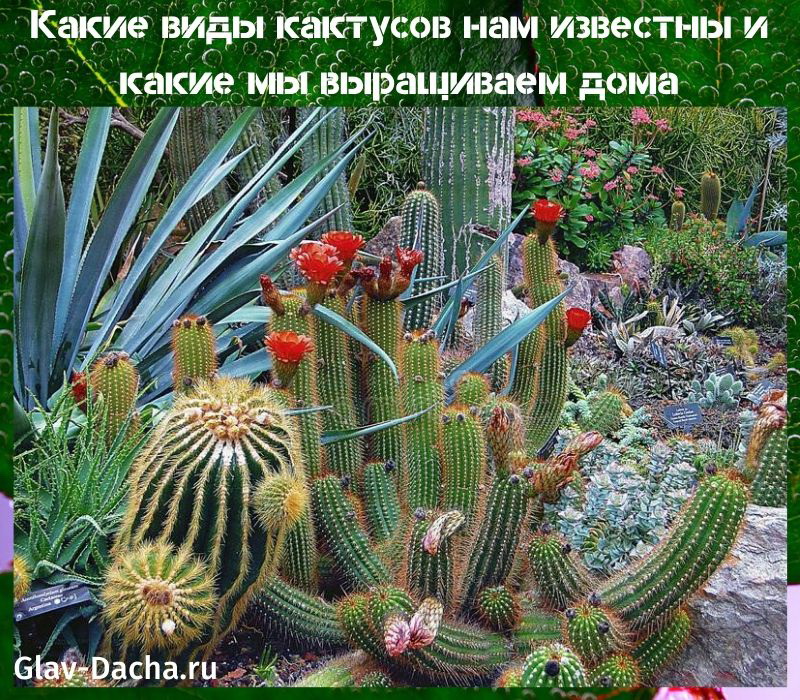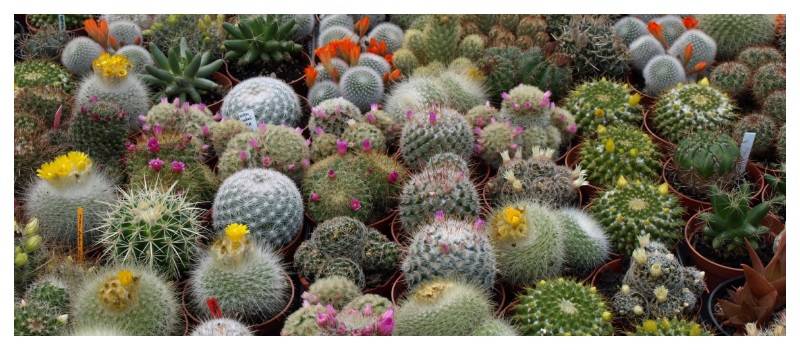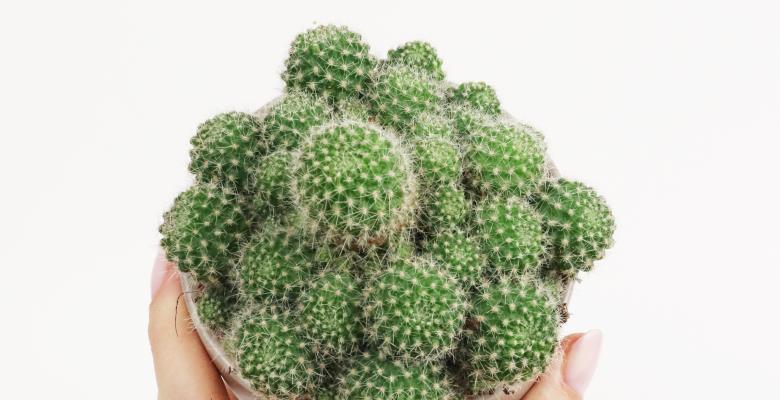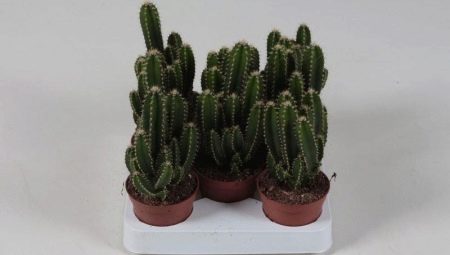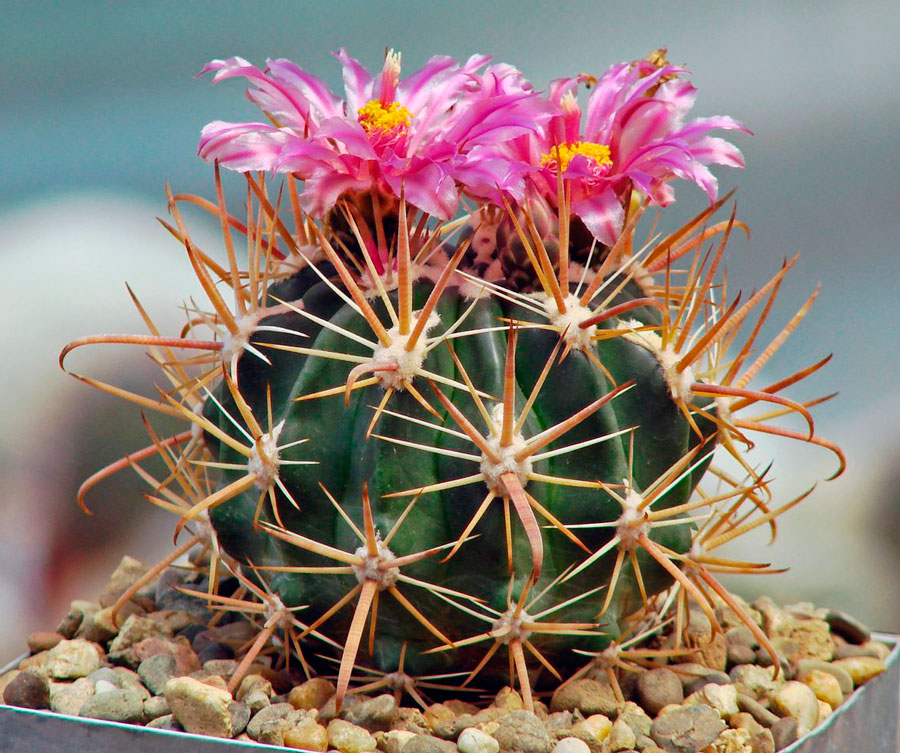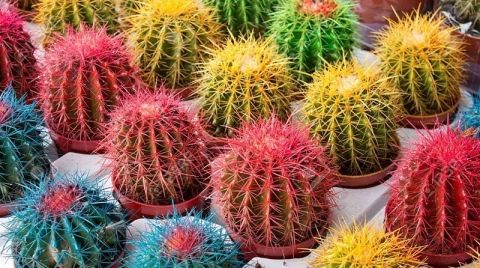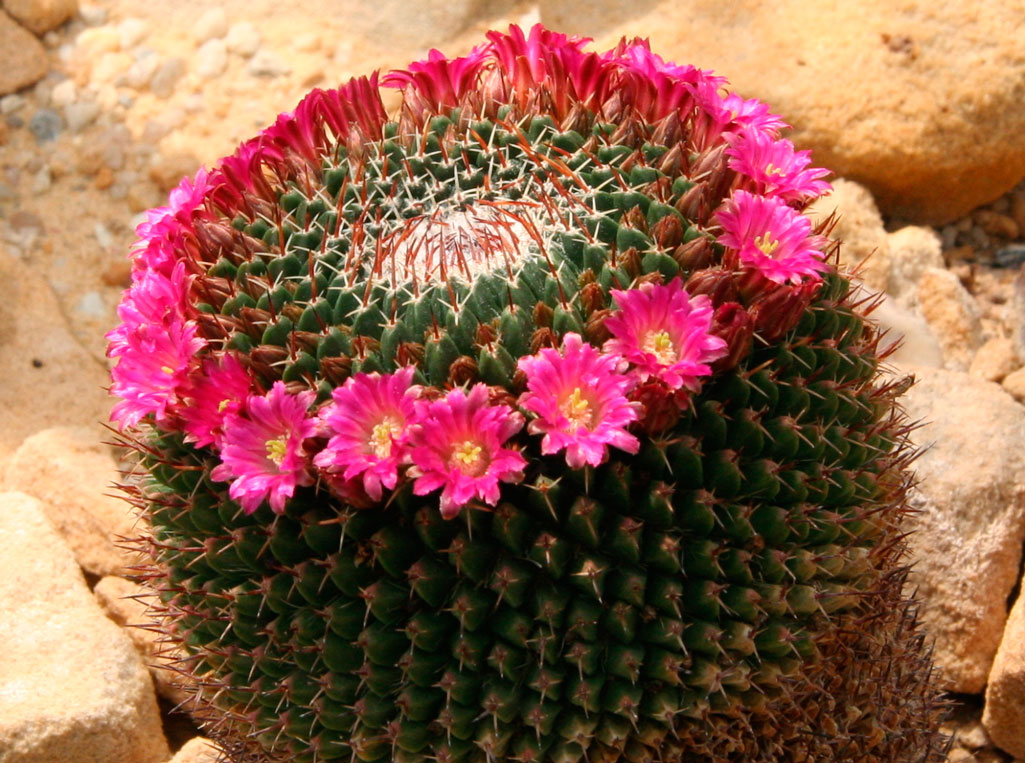The names of indoor cactus species
The following are the types of indoor cacti with the names and brief characteristics of crops and varieties.
The whip-shaped aporocactus (Aporocactus flagelliformis) is easy to grow. Its stems, 1 cm thick, grow a few centimeters per year, and in spring flowers with a diameter of 8 cm appear. Suitable for hanging baskets.
Astrophytum capricorn (Astrophytum capricorne) grows at first as a ribbed ball, but becomes cylindrical with age. Yellow chamomile flowers form in summer on adult specimens, which reach 15-30 cm, depending on the species. A. capricorne has curved spines; A. decorated (A. ornatum) has long straight spines.
The Peruvian Cereus (Cereus peruvianus) is one of the most important cacti for interior design, suitable for growing as a separate plant. The stem eventually reaches 0.6-1 m and blooms in summer with large flowers 15 cm long. The form of C. Peruvian Monstrozus - (C
peruvianus monstrosus) is a slowly growing "ugly" mutation that attracts attention
Chamaecereus silvestrii grows rapidly; red flowers appear on its stems 8 cm long in early summer.
Strauss's Cleistocactus (Cleistocactus straussii) is another design-friendly cactus. In adulthood, it reaches 1 m or more. The white hairs and thorns that cover the surface give the plant a silvery appearance.
Echinocereus pectinatus (Echinocereus pectinatus) grows into a column 25 cm high, studded with thorns. E. Salm-Dyck (E. salm-dyckianus) has fragrant bright flowers.
Gymnocalycium Mikhanovich, a variety of Friedrich (Gymnocalycium mihanovichii friedrichii) is also called Hibotan, or Little Red Riding Hood. Its colored stem is grafted onto a green cactus stock. It is an attractive and original cactus.
Mammillaria bocasana is a silvery plant that blooms in spring with white flowers arranged in a ring around the stem. M. Wilda (M. wildii) is similar to her, but has an oval rather than round shape.
Otto's Notocactus (Notocactus ottonis) is spherical, with hard spines. At the age of several years, it has flowers 8 cm wide. N. Leninghaus (N. leninghausii) is grown for its cylindrical stem, and not for the flowers.
Prickly pear (Opuntia microdasys) grows to a height of about 30 cm and bears small hooked spines. They can be red or white, depending on the species. Opuntia come in a variety of shapes and sizes.
The tiny Rebutia (Rebutia miniscula) has spherical stems 5 cm in diameter. It is capable of blooming with deep orange tubular flowers every summer. R. senilis is a ball with a diameter of 8-10 cm.
Whitening Trichocereus (Trichocereus candicans) in its mature state is a stately plant - a column 1 m high, which freely expands as it grows older. T. spach (T. spachianus), reaching a height of 1.5 m or more.
Power supply:
 Pointing out
Pointing out
 Bustle
Bustle
.
 Flare
Flare
 Flap, flap, flare, flare. Flip-flop
Flap, flap, flare, flare. Flip-flop
 Bridging
Bridging
 Lightning
Lightning
 Bumpy bump Bridging
Bumpy bump Bridging
.
 Power supply
Power supply
 Burgundy
Burgundy
Mammillaria
(Mammillaria)
 |
 |
 |
|
Mammillaria gracilis (graceful) Mammillaria gracili buy a cactus 2 - 2.5 cm. RUB 85 |
Mammillaria elongated Mammillaria elongata 5 cm. RUB 90 No |
Mammillaria wildi Mammillaria wildi 2.5-3 cm. 95 rub. |
|
|
|
|
|
Mammillaria elongated Mammillaria elongata 6 - 7 cm. RUB 85 No |
Mammillaria bokasskaya Mammillaria bocasana rosea 1.5 cm. buy a cactus RUB 85 |
Mammillaria wildi bush Mammillaria wildi 2 cm. RUB 85 (blooming 99 rub.) |
|
Mammillaria mammillaris Mammillaria mammillaris 1.8 - 2 cm. RUB 85 |
Senile mammillaria Mammillaria senilis (Mamillopsis) 1 cm. RUB 85 * |
Mammillaria glassy Mammillaria glassii L1537 1.5 cm. RUB 90 * |
 |
||
| Mammillaria duwei aff El Vergel, Guanajuato 1.7-2 cm 85 rub. |
Colombian mammillaria Mammillaria colombiana buy a cactus 2.5 cm. RUB 90 |
Mammillaria satin Mammillaria bombycina 4 - 4.5 cm. RUB 85 No |
|
Mammillaria boole (Bola) Mammillaria boolii grandiflorum
buy a cactus 1.5 cm. 99 rub. |
Mammillaria fraileana
buy a cactus 1.2 - 1.4 cm.95 rubles. No |
Bartschella schumannii 1.5 - 1.8 cm.
RUB 95 |
|
|
 |
|
|
Mammillaria the most thorny red Mammillaria spinosissima 2 cm. RUB 85 No |
Mammillaria the most thorny unapiko Mammillaria spinosissima var .una pica 3 - 3.5 cm. 120 RUB No |
Mammillaria geminispin Mammillaria geminispina 1.5 - 1.8 cm. buy a cactus RUB 85 |
 |
 |
 |
|
Mammillaria Basquebergiana variation Mammillaria backebergiana 1.8-2.2 cm. RUB 85 |
Celman's mammillaria Mammillaria zeilmanniana 1.8 - 2 cm. buy a cactus RUB 85 |
Mammillaria politele Mammillaria polythele 1.5 cm. buy a cactus 85 rubles |
|
Mammillaria majestic Mammillaria magnifica 5 cm. RUB 150 No |
Mammillaria plumosa Mammillaria plumosa 1.5 cm. RUB 90 No |
Mammillaria varabilis? Mammillaria variabilis 1.5 - 2 cm. RUB 85 No |
 |
||
|
Mammillaria densely spiky Mammillaria densispina (yellow flowers) 3 cm. buy a cactus RUB 90 * No |
Mammillaria ribbon Mammillaria lenta Torreon 1.2 -1.5 cm. RUB 80 No |
Mammillaria carmen Mammillaria carmenae Tamaulipas 2 cm. RUB 80 * No |
|
|
||
|
Mammillaria baskebergiana Mammillaria backebergiana 2 -2.5 cm. RUB 85 |
Mammillaria graceful long thorn. Mammillaria gracilis 3 - 3.5 cm. RUB 90 No |
Mammillaria bokasana multilanata
Mammillaria bocasana v.multilanata 1.5-1.7 cm. RUB 90 * |
|
Krayntsiya Gyultsova robustion Krainzia guelzowiana var robustior 1.7 - 1.9 cm. 120 rubles * No |
Mammillaria tape Mammillaria lenta 1 cm. RUB 85 * |
Extremia longiflora Krainzia longiflora 1 cm RUB 99 * No |
* - the photo shows exactly the cactus that is on sale.
Buy cactus
Astrophytums >>>
To order cacti, you need to tell me the name of the cactus you like from the catalog. Just copy the names indicated under the photos in the tables and paste them into the letter or feedback form.
The indicated price includes: cactus pot (5 rubles. Pcs. From 2020) soil (temporarily I do not send, only for self-pickup) expanded clay. For packing for mailing and seating in pots, you do not pay extra for anything! Those who take it personally, take with them "ready-made" cactus and do not suffer with the search for a suitable pot and soil.
When sending by mail, at your request, I send everything in a separately packed form. Upon receipt, you simply plant the plants in pots with their "native" soil. Instructions for planting cacti after receiving. But please note that sending along with the soil increases the cost of postal delivery of cacti.
Conditions for keeping cleistocactus
Cleistocactus is unpretentious to the conditions of detention, therefore it is very easy to care for. It is suitable for breeding even for novice growers.
Lighting. Succulent plants grow well in bright sunlight, but can thrive in partial shade. Direct rays cannot harm this plant. On the contrary, being constantly in the shade, not receiving enough light, cactus shoots begin to bend, which negatively affects the appearance of this culture.
Air temperature. Cleistocactus is thermophilic, easily tolerates extreme heat and drought. It is recommended to keep the plant outdoors in summer. A succulent plant is not afraid of drafts and temperature changes. It should be borne in mind that he cannot stand temperatures below +5 degrees.
Watering. Watering the fleshy succulent should be done carefully, as it accumulates water and does not need an abundance of moisture. Before the next watering, the soil should have time to dry out. Otherwise, a white bloom forms on its surface, which is a fungus.
Air humidity. The cactus grows well even in dry air conditions. It must be sprayed periodically to avoid the attack of harmful insects.
The soil. The soil should be loose, air and water permeable. You can purchase a ready-made soil mixture for succulents, or mix sod, leafy soil, peat, coarse sand.
Transfer. Young specimens are transplanted annually. Older individuals as needed, when the roots cease to fit in the pot.
Reproduction. Cleistocactus is propagated using seeds and shoots.Seeds can be sown at any time of the year, but they need to be germinated in greenhouse conditions, covered with foil or glass. After sowing, the substrate is moistened with a spray bottle. Crops care consists in airing and moistening them.
When propagating by shoots, the baby is separated from the mother plant with a sharp knife, left for several days to dry in a ventilated room. After that, they are placed in the soil and watered. Rooting is quick and painless for the plant.
Diseases and pests
Euphorbia is not whimsical in care, however, failure to comply with the basic requirements for care can lead to plant disease.
Diseases arising from milkweed:
- Leaves turn yellow and fall. This phenomenon is associated with improper care of the succulent. If milkweed leaves fall and dryness, then this indicates a lack of light, watering or the presence of dry air;
- Gray rot. This phenomenon is associated with excessive humidity;
- Tobacco mosaic. This phenomenon is characterized by the appearance of a pattern of yellow-red-brown colors. This is usually a sign of whitefly infestation.
Various insects can harm the plant, from which you should carefully protect the spurge.
Harmful insects:
- Aphid. The appearance of this insect on a plant is characterized by deformation and leaf fall;
- Whitefly. The first signs of the appearance of this pest are the appearance of white and yellow spots on the leaf of the plant;
- The appearance of a red mealybug on a plant is characterized by the accumulation of white insects on the roots of the plant.
Euphorbia is one of the favorite plants among flower growers, which is popular in many countries of the world. The plant belongs to the genus of succulents, therefore it has the property of retaining moisture, which makes it more resistant to various temperature fluctuations.
Main varieties
According to different classifications, espostoas have from 10 to 16 varieties. At home, miniature species of this cactus are usually grown, but large plants can also be found in rare collections. Espoo cactus differs not only in size, but also in the color of the stem and fluffiness.
Espostoa woolly
Woolly Espostoa (Lanata) is the most popular variety for home breeding.
This plant has the form of a pillar, from which lateral ribs extend in an amount of up to 30 pieces. Under natural conditions, the size of a furry cactus can reach 5 m, but a houseplant usually does not grow above 1 m.
On an adult plant, additional shoots appear, due to which the cactus begins to branch far from the base. More radial needles with a yellowish color break through the wool. The spines can be up to 5 cm long.

Young espostoa lanata
Espostoa is amazing
This type of fluffy cactus is almost white in color - it can range from light green to grayish. The stem diameter can be 9 cm, and the length is 0.5 m. In the wild, these data also differ, but indoor conditions do not allow the plant to grow very much.
The top of the plant is covered with a large number of long white hairs that stick out in different directions. Large areoles with acicular spines in the center and bristly radial spines are whitish-red in color.
Longer spines are located in the lower part of the plant, which makes the espostoa surprisingly different from other species.
Other varieties
Espostoa nana has an increased fluffiness, which is combined with the small size of the plant itself. At home, the succulent does not bloom, but some decide to grow it for the sake of its appearance, resembling a fur roller.
The shaggy Ritteri cactus is quite long (up to 4 m) with a significant number of dark branches. One column has up to 20 small ribs, which are separated by transverse grooves.The cactus is distinguished by the presence of one central thorn, which has a dark color, which can reach 2 cm. The rest of the needles are yellowish or brownish, while one Ritteri usually has about 25 thorns.
The black-columnar espostoa is considered a rather exotic species. The cactus got its name for a long trunk that resembles a column. The shade of the trunk can range from dark green to black. In nature, plant height reaches 2 m.

Black Column Espoo
Interesting information! The cactus is almost completely covered with white long hairs that protect it from pests. The plant has 24 ribs that are completely covered with hairs, but brown spines can be seen among them.
Espostoa senilis (senile) grows in Peru. A fairly tall pillar-like plant, white straight spines of which resemble hairs. The radial thorns are densely located on the stem, while the central thorns appear only on adult plants. Flowering occurs only in natural conditions.
Blossfeldia tiny
The smallest cactus known to science, representatives of the monotypic genus Blossfeldia. They choose small rocky crevices for life, where they cling with their roots to narrow areas of soil with amazing tenacity. These are plants with small pea-stems, the top of which is slightly flattened. They are characterized by very slow growth, the formation of lateral shoots occurs only with age, when the root system is sufficiently developed. Through the cracking skin on the stem, babies appear, as their number increases, the plants become like stony heaps.
The Blossfeldia has a reputation as a "deceiving cactus", as it lacks all the hallmarks of a cactus, be it ribs, tubercles or thorns.
Only the lightest pubescence of the areoles with a spiral arrangement on the stem betrays its belonging to the family of thorny plants. The flowering period occurs in early spring, at which time the Blossfeldia with wide-open white or pale pink flowers looks simply charming.
All about growing cacti at home in the video below.
Care rules
It is necessary to take care of a blooming cactus correctly. The further viability of the plant and the abundance of flowering depend on this. During this beautiful period, optimal conditions must be maintained for the succulent.
- Lack of transfers. Even if it seems to you that there is not enough space for the cactus in the pot, the transplant should be left for later. By stirring a flowering plant, you can completely stop flowering, not only at the moment, but also for subsequent years.
- No fertilizers. During flowering, you need to eliminate any stress for the cactus - both negative and positive. Fertilizers can provoke increased plant growth, which will have a negative effect on the further bud set.
- The location of the cactus must be constant. The plant prepares the buds for flowering for a long time, choosing the optimal place on the trunk for their formation. If, during flowering and budding, the succulent is deployed and moved, this can provoke a stop of these periods.
- The direction of the light should not change. Even a new curtain can ruin the bloom of a cactus. This period is not a time for experimentation. The sun's rays should fall on the plant in one position.
- Optimal watering. During flowering, cacti should receive enough moisture. The water should not be too cold. It is better to water the plant during this period every 3-5 days.
- Airing. During the flowering period, one should not forget about the flow of fresh air. Without oxygen and movement of air masses, the plant may not receive the necessary stress for high-quality budding.
For information on how to make a cactus bloom, see the next video.








